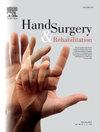Le Syndrome du Défilé Thoracique — L’algorithme du traitement
IF 0.9
4区 医学
Q4 ORTHOPEDICS
引用次数: 0
Abstract
The symptoms of Thoracic Outlet Syndrome (TOS) are due to the compression of the brachial plexus or the subclavian vessels. It causes pain, a sensation of heaviness, and paresthesias in the corresponding upper limb. The syndrome can have neurological, vascular, or mixed etiology. The aim of this study is to evaluate patients who underwent surgical decompression of the brachial plexus via a supraclavicular approach and detachment of the pectoralis minor tendon from the coracoid process.
From 2020 to 2023, a retrospective analysis was conducted on 12 patients (3 men and 9 women) with an average age of 35 years (range 25–55) with TOS of neurological or mixed etiology. They underwent surgical supraclavicular decompression of the brachial plexus with scalenectomy and detachment of the pectoralis minor tendon from the coracoid process through a second incision above the coracoid process. No patient presented with a cervical rib or bony anomaly of the cervical spine. The diagnosis was based on clinical presentation, imaging studies, electromyography, and dynamic color Doppler ultrasound (triplex) of the subclavian artery in 90? and 120? abduction of the affected limb. All patients underwent physical therapy sessions for 3–6 months preoperatively without clinical improvement. Postoperatively, the upper limb was suspended with movement allowed within pain limits. Patients were clinically assessed at 1, 3, 6, and 12 months postoperatively. The outcomes were classified as satisfactory with complete symptom relief, good with symptom reduction, and poor in patients with no clinical improvement.
The mean follow-up time was 15 months (range 11–20). No postoperative infections or pneumothorax were observed. Two patients developed hematomas that did not require surgical drainage. No postoperative nerve injuries were noted. The outcomes were excellent with complete symptom resolution in 75% of cases, good with partial symptom resolution in 16.6%, and poor with no symptom improvement in 8.3%. The mean preoperative VAS score was 6, while the postoperative score was 1. The mean preoperative and postoperative DASH scores were 70 and 38, respectively.
TOS is a demanding pathology whose treatment requires of high expertise. Electric potentials contribute to the identification of each nerve branch.
TOS requires careful differential diagnosis and surgical expertise. It reduces the functionality of the upper limb and causes significant discomfort to the patient. Surgical intervention leads to good outcomes with symptom reduction or resolution, improving the patients quality of life. Supraclavicular and coracoid release of the brachial plexus is indicated in cases without cervical ribs or bony anomalies in the area.
求助全文
约1分钟内获得全文
求助全文
来源期刊

Hand Surgery & Rehabilitation
Medicine-Surgery
CiteScore
1.70
自引率
27.30%
发文量
0
审稿时长
49 days
期刊介绍:
As the official publication of the French, Belgian and Swiss Societies for Surgery of the Hand, as well as of the French Society of Rehabilitation of the Hand & Upper Limb, ''Hand Surgery and Rehabilitation'' - formerly named "Chirurgie de la Main" - publishes original articles, literature reviews, technical notes, and clinical cases. It is indexed in the main international databases (including Medline). Initially a platform for French-speaking hand surgeons, the journal will now publish its articles in English to disseminate its author''s scientific findings more widely. The journal also includes a biannual supplement in French, the monograph of the French Society for Surgery of the Hand, where comprehensive reviews in the fields of hand, peripheral nerve and upper limb surgery are presented.
Organe officiel de la Société française de chirurgie de la main, de la Société française de Rééducation de la main (SFRM-GEMMSOR), de la Société suisse de chirurgie de la main et du Belgian Hand Group, indexée dans les grandes bases de données internationales (Medline, Embase, Pascal, Scopus), Hand Surgery and Rehabilitation - anciennement titrée Chirurgie de la main - publie des articles originaux, des revues de la littérature, des notes techniques, des cas clinique. Initialement plateforme d''expression francophone de la spécialité, la revue s''oriente désormais vers l''anglais pour devenir une référence scientifique et de formation de la spécialité en France et en Europe. Avec 6 publications en anglais par an, la revue comprend également un supplément biannuel, la monographie du GEM, où sont présentées en français, des mises au point complètes dans les domaines de la chirurgie de la main, des nerfs périphériques et du membre supérieur.
 求助内容:
求助内容: 应助结果提醒方式:
应助结果提醒方式:


